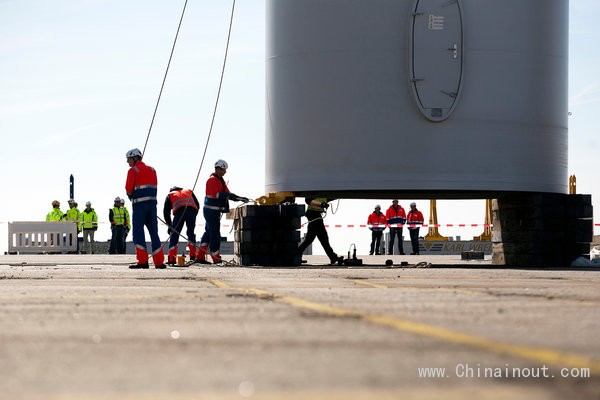德国黑尔戈兰岛——几乎没有哪个发达国家会像德国这般卖力地寻求全球变暖的解决之道。现在,一些高耸的大家伙作为这项努力的象征,出现在了北海中。
它们是风力涡轮机,屹立在距内陆60英里的地方,足有60层楼那么高,每台耗资达3000万美元。这些机器都是庞然大物,有的光是上边的一个叶片,大小就和天空中最大的客机——空客A380——差不多了。今年年底前,数十台新安装的涡轮机会给向南数百英里处的德国城市供应清洁电能。
这将是德国耗资巨大的电力系统改造工程的又一个里程碑。此项宏大的工程已经取得了惊人的成效:可再生能源对该国电力供应的贡献率很快就能达到30%。这对很多小国而言可能不在话下,但迄今为止,德国是近现代达到这一水平的工业国中最大的一个。30%的比例较美国高出一倍多。
德国在不断地推进可再生能源的开发利用,其影响远远超出了它的国界。通过催生出对风力涡轮机和太阳能板(尤其是后者)的巨大需求,它在将中国大型制造企业吸引到这个市场的过程中发挥了作用,由此产生的合力正让成本飞速下降——几年前根本没人料到会降得如此之快。
全球的电力公司高管们,眼睁睁看着一度被自己视作无关紧要的技术开始威胁到自家公司长期以来的经营方略,无不如坐针毡。美国各地都爆发了有关可再生能源电力未来规则的讨论。许多曾打算通过建造燃煤发电厂来为国民供电的穷国,眼下正探讨是否可以跳过化石燃料时代,从一开始就构建清洁能源网络。
清算的时刻到了,而德国的情况可能比任何地方都要明了。几乎每个月,德国都会刷新可再生能源电力的生产纪录,但与此同时,这些变化让该国的公用事业公司损失惨重,来自电力生产的利润一路狂跌。
类似的情况很可能出现在其他那些正推行宏大的可再生能源规划的国家。美国的一些州对华盛顿的立法僵局失去了耐心,已经自行设立了雄心勃勃的目标:在2020年之前就要让可再生能源对电力供应的贡献率达到20%至30%。
德国人把自己的方案叫“能源转型”(energiewende),这个词已经开始被其他国家和地区的一些人挂在嘴边。德国被全世界奉为楷模,环保人士常常以它为例来证明,全球能源系统的转型是可以实现的。
但人们越来越清楚地看到,这种转型即便可行,也会是一个痛苦的过程。一些业内人士称,电力产业进入了它130年的历史上最激烈的动荡期,它正迎来一场裂变,其影响可能堪比航空、音乐以及电话产业曾经发生的那些重塑产业格局的大裂变。
行业观察人士表示,要充分利用这种可能性,也许就得抛开电力市场的旧有规则,重新规划——大概还得作一些安排,比如向公用事业公司额外付费,让其保留传统发电厂备用,以应付风力和日照不足的情况。德国政府已经认识到了启用新规则的必要性,尽管它还没弄清新规则该是什么样。美国的少数几个州同样在重新思考本州电力系统的运行方式。
“正在发生的一切真的十分惊人,”在柏林做德国能源项目的爱尔兰投资人杰拉德·里德(Gerard Reid)说,“德国人称之为转型,但在我看来这是一场革命。”
如果能正确地创建新规则,就有机会获得巨大的回报:有一个更为环保的、不再向大气中排放那么多温室气体以及其他污染物的电力系统。不过德国的经验表明,转型的困难同样是巨大的;而且目前还远远不能确定该系统的转型速度是否能快到足以防止全球变暖达到危险的程度。
“我相信,风和阳光将会成为主要的能量来源,不光在德国,在全世界都是如此。”致力于能源转型研究的柏林智库阿哥拉能源转型(Agora Energiewende)的负责人帕特里克·格赖兴(Patrick Graichen)说,“问题是:我们怎样才能让这场能源转型成为成功的范例。”
暴跌的价格
不久前的一天,在加利福尼亚州明媚的阳光下,工人们手拿嗡嗡作响的电锯,给宽敞的新房加上最后的点缀。这些新房坐落在洛杉矶以南的奥兰治县,看起来跟当地的其他房屋没有太大差别,但它们都有一个附加特性:莱纳公司(Lennar Corporation)给自己盖的每一栋房子都安装了太阳能面板。
过去五年,太阳能板的价格大跌了70%。这种暴跌意味着用太阳能供电开始变得更加经济了,尤其是在美国一部分电价较高的地区。
在加利福尼亚州约100个由莱纳公司兴建的住宅小区里,买家搬进新房时,就自动获得了屋顶的太阳能板。作为美国第二大住宅建筑商的莱纳公司,最近决定从科罗拉多州开始,在其他几个州推广这种做法。该公司通常会保留这些组件的所有权,并和房主签定为期20年的合同,让他们买下产自自家屋顶的电力,价格比当地公用事业公司的报价低20%。
这个太阳能计划由莱纳事业部(Lennar Ventures)负责,其总裁大卫·J·凯泽曼(David J. Kaiserman)说,“当我们告诉客户‘包你省钱'时,事情就变得非常简单了。”
在很大程度上,这种经济性变化是中国——在德国带动之下——发挥作用的结果。过去10年间,德国人让一度不成规模的可再生能源电力市场实现了快速增长,从而降低了走绿色之路的成本。
德国已经在其能源转型方案上投入了1400多亿美元,并以固定收益诱惑有意安装太阳能板、风力涡轮机、沼气池等可再生能源设备的农民、屋主、企业以及当地的合作社。该方案的成本要通过征收可再生能源电价附加费来弥补,一个普通德国家庭每年大约要缴纳280美元,不过,由于可再生能源拉低了趸售电价,此项开支被抵消了一部分。
德国的这一方案帮助扩大了可再生能源市场的规模,带来了巨大的规模效应——过去10年,太阳能板的全球销量每隔21个月就会翻倍,而销量每翻倍一次,价格就会降低20%左右。“德国人投入重金,买的不是电,而是价格的下降。”旧金山一家能源智库的负责人哈尔·哈维(Hal Harvey)说。
在这种连锁反应下,美国的一些生产商被迫关门歇业,中国政府向占据了很大一部分市场份额的本国厂商发放补贴之举,引人抱怨。不过,价格的下降也为美国的屋主以及莱纳这样的公司带来了机会。
近年来,风电价格也大幅下降。目前,风电在成本上可以和美国部分地区新建的燃煤电厂匹敌。
企业面临的威胁
可再生电力成本的下降,对电力生产企业构成了威胁。让这些企业大赚特赚的,是一天当中电力需求大、电价也随之升高的时段。而太阳能就算规模不大,也有可能给市场带来极大的冲击,把用电高峰期的趸售电价拉下来。
尽管光电产业发展得很快,但光电产量在美国电力总产量中所占的比重还不到1%,因此美国市场尚未受到大规模的冲击。不过,有的公用事业公司担心自己因电源结构的变化而遭受损失,已经开始攻击那些鼓励使用太阳能面板的规则了。另外一些公司则采取了相反的策略,干脆投身到了光电市场之中。
紧随这些公用事业公司之后的,是高速成长的初创公司,它们正把数以万计的太阳能板安在人们的屋顶上,并和屋主签下无需付押金的租约,为其提供资金支持的是华尔街的银行机构。加利福尼亚州被卷入了这股热潮之中,该州计划在2020年之前把可再生能源电力上网比重提高到33%,现在看来,实现这一目标的可能性正逐步加大。
在德国,太阳能面板和风力涡轮机的发电量分别占总发电量的7%和10%,一度最有利可图的用电高峰期的趸售电价已经大幅下降。公用事业巨头莱茵集团(RWE)的首席执行官彼得˙特里乌姆(Peter Terium)于今年春天宣布该集团亏损了38亿美元时承认:“我们进入可再生能源市场的时间有些晚——也许是太晚了。”
德国的这些大型公用事业公司提醒说——也许可以称之为恳求——这场革命要想进行下去,就得带上它们。外部专家称,他们的话或许有点道理。
可再生能源有一个致命的弱点,即供电的间歇性。因此,德国的公用事业公司不得不通过迅速调高或调低传统发电厂的发电量来保持供需平衡。以这种方式运营的传统发电厂未必有利可图,公用事业公司一直扬言要关闭这些电厂,但有分析人士认为德国需要用它们来应对不时之需。
由于德国政府决意放弃核能,情况变得越发复杂。2011年日本福岛核泄漏事故发生后,在德国存在已久的核电站存废之争终于有了结果:该国政府宣布将用10年时间关闭国内的核电站。随着这一计划的实施,清洁电能的一个来源将被切断,德国在温室气体减排方面取得的令人瞩目的成绩已经停滞不前。
事实上,能源转型带来的问题在过去几年里迅速增多,以致于德国政府正竭力放缓转型的脚步。“我认为我们还需要一点点时间,”德国环境部副部长约亨·弗拉斯巴斯(Jochen Flasbarth)说。
技术创新
可再生能源开始让电力供给和价格产生波动之际,有专家认为,如果新建立的市场规则足够明智,应该可以把成本控制在合理范围内。
他们所推荐的一些新制度,在某种程度上已经得到了应用——这些制度是由美国率先实施的,德国正在积极研究。其中包括定期付费给公用事业公司,令其保留一些化石燃料发电厂,在可再生能源短缺时作应急之用。
“就好比你向你的律师支付聘金,以确保她在你需要的时候一定会出现,”卡内基梅隆大学(Carnegie Mellon University)的电力专家杰伊·阿普特(Jay Apt)说。
对德国人而言,由于内陆地区可再生能源电力的产量存在不可预测性,海风的吸引力便显现了出来。北海和波罗的海上空的风力强大而稳定,意味着安装在那里的涡轮机在发电量上远远高于内陆地区的涡轮机。
正因为如此,三家公用事业公司差不多算是把黑尔戈兰岛给占领了,直接与这个度假小岛上的一家酒店签下了10年的租约。它们正按照长期规划建设风电场,一直要建到距海岸125英里远的地方,而黑尔戈兰岛是最适合用来做行动基地的一片陆地。
小岛的街道上挤满了待遇优厚的工人。“真的,黑尔戈兰岛每个地块都在获益,”当地一家兼售户外用品的加油站的经理艾克瓦·伦达(Eike Walenda)说。
当然了,海上风电场的建设费用远高于陆地上的费用。每台涡轮机高达3000万美元的身价不仅仅是机器本身的价格,还包含了电缆费、安装费等好多项费用。为了吸引公用事业公司参与这样的项目,德国政府不得不答应它们把电价提高到市价的好几倍。
不过,德国人预计在未来10年里,海风发电的成本可以随着市场规模的增长而大幅下降——就像早期的那些可再生能源发电技术那样。要是成本真降下来,美国也许会成为受益者。有研究表明,海风发电可为东海岸城市供应其所需电量的15%至20%;而且美国的几个项目很快就要开工建设了。
德国消费者已经为太阳能板、内陆地区的风力涡轮机、沼气池,以及向可再生能源时代过渡所需的其他一切承担了高昂的成本,现在,他们又要因海风电场而多承担数十亿美元。民意调查显示,他们乐意担起这副担子。
“事实上,德国民众正付出高昂的代价,”能源智库阿哥拉能源转型的分析师马库斯·施泰根贝格尔(Markus Steigenberger)说,“但在德国,我们能够承担得起——我们是富裕国家。这是我们给世界的礼物。”(中国进出口网)
HELIGOLAND, Germany — Of all the developed nations, few have pushed harder than Germany to find a solution to global warming. And towering symbols of that drive are appearing in the middle of the North Sea.
They are wind turbines, standing as far as 60 miles from the mainland, stretching as high as 60-story buildings and costing up to $30 million apiece. On some of these giant machines, a single blade roughly equals the wingspan of the largest airliner in the sky, the Airbus A380. By year's end, scores of new turbines will be sending low-emission electricity to German cities hundreds of miles to the south.
It will be another milestone in Germany's costly attempt to remake its electricity system, an ambitious project that has already produced striking results: Germans will soon be getting 30 percent of their power from renewable energy sources. Many smaller countries are beating that, but Germany is by far the largest industrial power to reach that level in the modern era. It is more than twice the percentage in the United States.

Germany's relentless push into renewable energy has implications far beyond its shores. By creating huge demand for wind turbines and especially for solar panels, it has helped lure big Chinese manufacturers into the market, and that combination is driving down costs faster than almost anyone thought possible just a few years ago.
Electric utility executives all over the world are watching nervously as technologies they once dismissed as irrelevant begin to threaten their long-established business plans. Fights are erupting across the United States over the future rules for renewable power. Many poor countries, once intent on building coal-fired power plants to bring electricity to their people, are discussing whether they might leapfrog the fossil age and build clean grids from the outset.
A reckoning is at hand, and nowher is that clearer than in Germany. Even as the country sets records nearly every month for renewable power production, the changes have devastated its utility companies, whose profits from power generation have collapsed.
A similar pattern may well play out in other countries that are pursuing ambitious plans for renewable energy. Some American states, impatient with legislative gridlock in Washington, have set aggressive goals of their own, aiming for 20 or 30 percent renewable energy as soon as 2020.
The word the Germans use for their plan is starting to make its way into conversations elsewher: energiewende, the energy transition. Worldwide, Germany is being held up as a model, cited by environmental activists as proof that a transformation of the global energy system is possible.
But it is becoming clear that the transformation, if plausible, will be wrenching. Some experts say the electricity business is entering a period of turmoil beyond anything in its 130-year history, a disruption potentially as great as those that have remade the airlines, the music industry and the telephone business.
Taking full advantage of the possibilities may require scrapping the old rules of electricity markets and starting over, industry observers say — perhaps with techniques like paying utilities extra to keep conventional power plants on standby for times when the wind is not blowing and the sun is not shining. The German government has acknowledged the need for new rules, though it has yet to figure out what they should be. A handful of American states are beginning a similar reconsideration of how their electric systems operate.
"It's pretty amazing what's happening, really," said Gerard Reid, an Irish financier working in Berlin on German energy projects. "The Germans call it a transformation, but to me it's a revolution."
The potential payoff for getting the new rules right is enormous: a far greener electricity system that does not pump as much greenhouse gas and other pollution into the atmosphere. Yet as the German experience shows, the difficulties of the transition are likely to be enormous, too, and it is still far from clear whether the system can be transformed fast enough to head off dangerous levels of global warming.
"I am convinced that wind and sun will be the central sources of energy, not only in Germany but worldwide," said Patrick Graichen, who heads a think tank in Berlin, Agora Energiewende, devoted to studying the shift. "The question is: How can we turn the energy transition into a success story?"
Plummeting Prices
One recent day, under a brilliant California sun, saws buzzed as workers put the finishing touches on spacious new homes. They looked like many others going up in Orange County, south of Los Angeles, but with an extra feature: Lennar Corporation was putting solar panels on every house it built.
The prices of the panels have plunged 70 percent in the past five years. That huge decline means solar power is starting to make more economic sense, especially in parts of the United States with high electricity prices.
At about 100 Lennar subdivisions in California, buyers who move into a new home automatically get solar panels on the roof. Lennar, the nation's second-largest homebuilder, recently decided to expand that policy to several more states, starting with Colorado. The company typically retains ownership of the panels and signs 20-year deals to sell homeowners the power from their own roofs, at a 20 percent discount from the local utility's prices.
"It's so simple when we tell a customer, 'You're guaranteed to save money,' " said David J. Kaiserman, president of Lennar Ventures, the division overseeing the solar plan.
The shifting economics can largely be traced to China, by way of Germany. Over the past decade, the Germans set out to lower the cost of going green by creating rapid growth in the once-tiny market for renewable power.
Germany has spent more than $140 billion on its program, dangling guaranteed returns for farmers, homeowners, businesses and local cooperatives willing to install solar panels, wind turbines, biogas plants and other sources of renewable energy. The plan is paid for through surcharges on electricity bills that cost the typical German family roughly $280 a year, though some of that has been offset as renewables have pushed down wholesale electricity prices.
The program has expanded the renewables market and created huge economies of scale, with worldwide sales of solar panels doubling about every 21 months over the past decade, and prices falling roughly 20 percent with each doubling. "The Germans were not really buying power — they were buying price decline," said Hal Harvey, who heads an energy think tank in San Francisco.
The ripple effects drove some American panel manufacturers out of business, prompting complaints about Chinese government subsidies to the manufacturers who seized much of the market. But the decline also created an opportunity for American homeowners and for companies like Lennar.
Wind power, too, has come down sharply in price in recent years, and it is now competitive with the cost of new coal-burning power plants in parts of the United States.
A Threat to Business
The decline in the cost of renewable power spells potential trouble for companies that generate electricity. They make a lot of their money at times of day when demand for power, and therefore power prices, are high. Solar power, even a small amount, could be especially disruptive, shaving wholesale prices during those peak periods.
Though growing rapidly, solar power still accounts for less than 1 percent of American power generation, so the disruption has not yet been seen on a large scale in the United States. But some utilities, fearful of losing out as the power mix changes, have started attacking rules that encourage solar panels. Others are taking the opposite tack, jumping into the solar market themselves.
Nipping at the heels of those utilities are fast-growing start-up companies that are putting tens of thousands of panels on rooftops and leasing them to homeowners for no money down, with Wall Street banks providing the financing. The hot spot is California, which is aiming for 33 percent renewable power by 2020 and seems increasingly likely to get there.
In Germany, wher solar panels supply 7 percent of power and wind turbines about 10 percent, wholesale power prices have crashed during what were once the most profitable times of day. "We were late entering into the renewables market — possibly too late," Peter Terium, chief executive of the giant utility RWE, admitted this spring as he announced a $3.8 billion annual loss.
The big German utilities are warning — or pleading, perhaps — that the revolution cannot be allowed to go forward without them. And outside experts say they may have a point.
The Achilles' heel of renewable power is that it is intermittent, so German utilities have had to dial their conventional power plants up and down rapidly to compensate. The plants are not necessarily profitable when operated this way, and the utilities have been threatening to shut down facilities that some analysts say the country needs as backup.
The situation is further complicated by the government's determination to get rid of Germany's nuclear power stations over the next decade, the culmination of a long battle that reached its peak after the 2011 Fukushima disaster in Japan. As that plan unfolds, shutting down a source of low-emission power, Germany's notable success in cutting greenhouse gases has stalled.
In fact, the problems with the energiewende (pronounced in-ur-GEE-vend-uh) have multiplied so rapidly in the past couple of years that the government is now trying to slow down the transition. "I think we need a little bit of time," said Jochen Flasbarth, a deputy minister of the environment.
Technological Innovation
As renewable energy sources start to cause gyrations in power supplies and prices, experts contend that clever new market rules could keep the costs reasonable.
Some of the innovations they recommend are already in use to some extent — pioneered in the United States, with Germany avidly studying them. They include regular payments to persuade utilities to keep some fossil-fuel power plants on standby for times when renewable sources lag.
"It's like a retainer you pay your lawyer to keep her around in case you need her," said Jay Apt, an electricity expert at Carnegie Mellon University.
For Germans, the unpredictability of onshore renewable power explains the appeal of offshore wind. The stiff, steady breezes in the North Sea and the Baltic Sea mean that turbines built there will produce far more power than land turbines.
That is why three utilities have virtually seized control of the tiny resort island of Heligoland, renting out one hotel for 10 years straight. It is the most convenient body of land to use as an operations base for the huge wind farms they are installing, with long-range plans to go as far as 125 miles offshore.
The streets of the island are thronged with well-paid workers. "Really, all areas on Heligoland are profiting," declared Eike Walenda, the manager of a local outfitter and fueling station.
The costs of building in the sea are far higher than on land, of course. The price tag of up to $30 million per turbine is not just for the machine itself, but also for power cables, installation and many other items. To induce utilities to go forward, the government has had to guarantee them power prices of several times the market rate.
But, just as with earlier forms of renewable technology, the Germans expect the costs of harnessing offshore wind to dro sharply as the market grows over the coming decade. If that happens, the United States could be a big beneficiary. Studies have shown that offshore wind could supply as much as 15 to 20 percent of the power needed by East Coast cities, and construction is about to start on a handful of American projects.
For now, the German offshore farms are adding billions to the costs consumers are already bearing for solar panels, onshore wind turbines, biogas plants and the rest of the transition to renewable energy. Polls suggest it is a burden they are willing to carry.
"Indeed, the German people are paying significant money," said Markus Steigenberger, an analyst at Agora, the think tank. "But in Germany, we can afford this — we are a rich country. It's a gift to the world."











